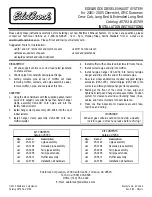
267
4-5. Using the driving support systems
4
Driving
Approximately 9.8 ft. (3 m) to 197 ft. (60 m) from the rear bumper
The greater the difference in speed between your vehicle and the detected
vehicle is, the farther away the vehicle will be detected, causing the outside
rear view mirror indicator to illuminate or flash.
■
The BSM function is operational
when
The BSM function is operational
when all of the following conditions
are met:
●
The BSM function is on.
●
The shift lever is in a position
other than R.
●
The vehicle speed is greater than
approximately 10 mph (16 km/h).
■
The BSM function will detect a
vehicle when
The BSM function will detect a vehi-
cle present in the detection area in
the following situations:
●
A vehicle in an adjacent lane over-
takes your vehicle.
●
You overtake a vehicle in an adja-
cent lane slowly.
●
Another vehicle enters the detec-
tion area when it changes lanes.
■
Conditions under which the
BSM function will not detect a
vehicle
The BSM function is not designed to
detect the following types of vehi-
cles and/or objects:
●
Small motorcycles, bicycles,
pedestrians, etc.
*
●
Vehicles traveling in the opposite
direction
●
Guardrails, walls, signs, parked
vehicles and similar stationary
objects
*
●
Following vehicles that are in the
same lane
*
●
Vehicles traveling 2 lanes away
from your vehicle
*
●
Vehicles which are being over-
taken rapidly by your vehicle
*
: Depending on the conditions,
detection of a vehicle and/or
object may occur.
■
Conditions under which the
BSM function may not function
correctly
●
The BSM function may not detect
vehicles correctly in the following
situations:
• When the sensor is misaligned
due to a strong impact to the sen-
sor or its surrounding area
• When mud, snow, ice, a sticker,
etc. is covering the sensor or sur-
rounding area on the rear bumper
• When driving on a road surface
that is wet with standing water
during bad weather, such as
heavy rain, snow, or fog
• When multiple vehicles are
approaching with only a small gap
between each vehicle
• When the distance between your
vehicle and a following vehicle is
short
• When there is a significant differ-
ence in speed between your vehi-
cle and the vehicle that enters the
detection area
• When the difference in speed
between your vehicle and another
vehicle is changing
• When a vehicle enters a detection
area traveling at about the same
speed as your vehicle
• As your vehicle starts from a stop,
a vehicle remains in the detection
area
• When driving up and down con-
secutive steep inclines, such as
hills, dips in the road, etc.
• When driving on roads with sharp
bends, consecutive curves, or
uneven surfaces
• When vehicle lanes are wide, or
D
Summary of Contents for RAV 4 2019
Page 7: ...7 TABLE OF CONTENTS 1 2 3 4 5 6 7 8 9 10...
Page 16: ...16 Pictorial index License plate lights P 210 Turn signal lights P 204 If equipped P Q...
Page 24: ...24 Pictorial index...
Page 106: ...106 3 1 Key information Certification for wireless remote control...
Page 168: ...168 3 5 Opening closing the windows and moon roof...
Page 228: ...228 4 5 Using the driving support systems...
Page 374: ...374 4 6 Driving tips...
Page 447: ...447 5 10 Tips for operating the audio visual system 5 Entune audio For vehicles sold in Canada...
Page 448: ...448 5 10 Tips for operating the audio visual system Gracenote...
Page 449: ...449 5 10 Tips for operating the audio visual system 5 Entune audio For U S owners...
Page 494: ...494 5 16 Toyota Entune overview For vehicles sold in the U S A Canada and Puerto Rico...
Page 537: ...537 6 4 Using the other interior features 6 Interior features...
Page 538: ...538 6 4 Using the other interior features...
Page 565: ...565 7 3 Do it yourself maintenance 7 Maintenance and care Rear...
Page 610: ...610 7 3 Do it yourself maintenance...
Page 656: ...656 8 2 Steps to take in an emergency...
Page 694: ...694 9 3 Initialization...
Page 706: ...706 10 1 For owners...
Page 707: ...707 Index What to do if Trouble shooting 708 Alphabetical Index 711...
















































